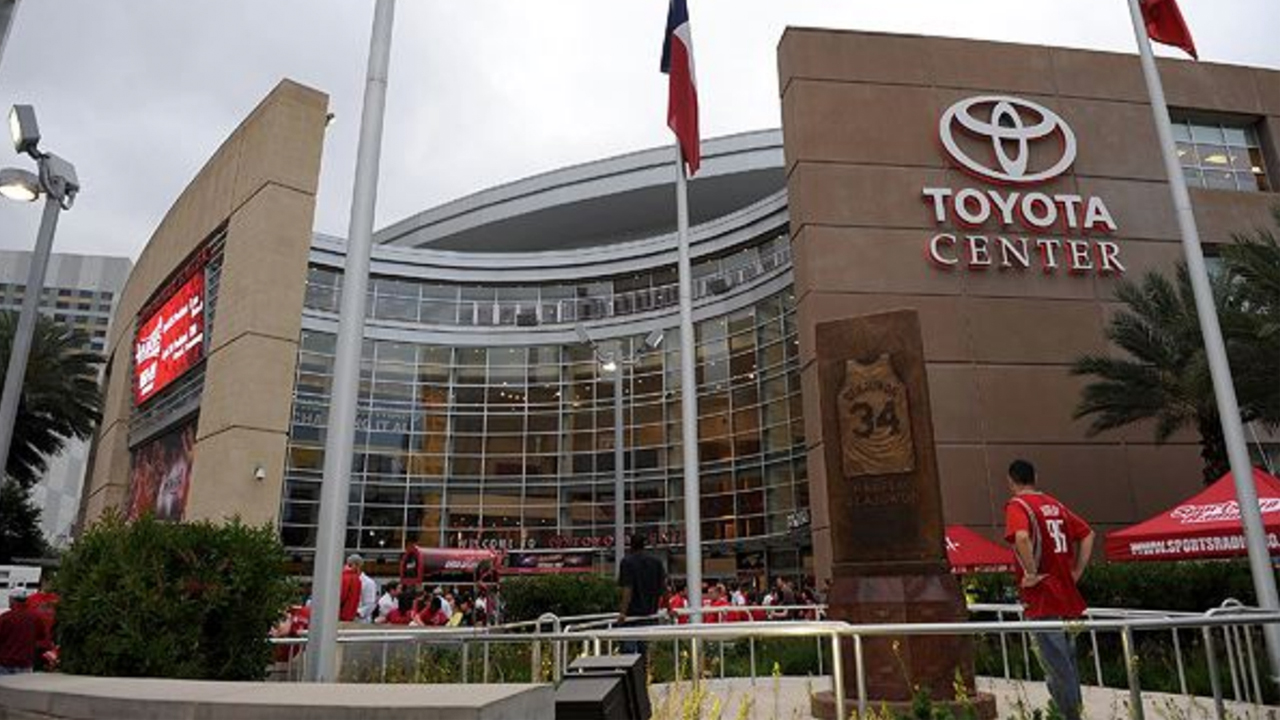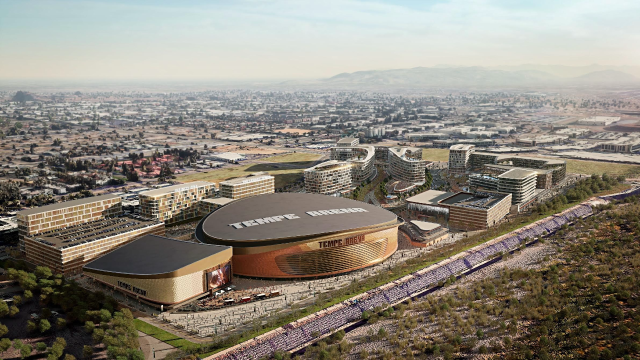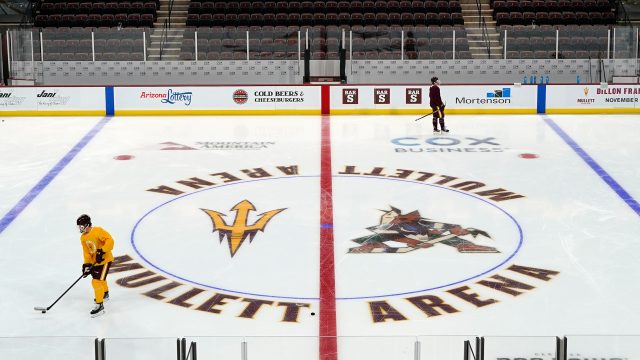
Let’s face it, with the plan for a new arena in Tempe being decisively voted down by area residents, the time has come to seriously consider relocating the Arizona Coyotes.
Playing in a 4,600-capacity college hockey arena with a vague idea about the future isn’t going to cut it in a major professional league.
No question, hockey fans in the Valley of the Sun — and they are legion — deserved much better. Can you imagine if your favourite team had gone through nine owners, constant franchise uncertainty and three local relocations in 26 seasons, and had made the playoffs once in its last 11?
One last dim hope remains: Mat Ishbia, the new owner of the NBA’s Phoenix Suns and WNBA’s Phoenix Mercury, is an owner willing to take chances.
“I would be surprised if Gary Bettman and the NHL, if they haven’t already, meet with him to gauge his interest in supporting the idea of turning the Suns’ current rink into a facility that could also support the Coyotes,” Sportsnet’s Elliotte Friedman told Jeff Marek on the latest edition of 32 Thoughts: The Podcast. “That would take some work, it might take two summers, it’ll take a couple hundred million dollars. … But I don’t think the NHL wants to abandon the Arizona market unless it absolutely has to.”
But the facts are the facts: a near-record turnout of residents to a local election spoke loudly and clearly that the Coyotes’ future is cloudy. The NHL and the Coyotes expressed similar comments of being “disappointed” in the results.
“We are very disappointed Tempe voters did not approve Propositions 301, 302, and 303,” Coyotes president and CEO Xavier Gutierrez said after the vote. “As Tempe Mayor Corey Woods said, this was the best sports deal in Arizona history.”
So, what’s next? Wild speculation of relocation has been rekindled.
But what makes the most sense? After 27 years, the mission in Arizona has apparently failed, so it’s likely time for the team to pack up its gear for good and move out of the state.
With this in mind, we’ve come up with a helpful list of cities the Coyotes can relocate to, listed with arena and arena capacity.
1. Salt Lake City, Vivint Arena, 14,000: If these were power rankings, this entry would be No. 1, especially since Utah Jazz and Real Salt Lake owner Ryan Smith met in late March with NHL commissioner Gary Bettman, as reported by Sportsnet’s Elliotte Friedman. And Smith, who bought the building and the Jazz in December 2020, hasn’t exactly dampened the enthusiasm, replying to a fan’s tweet asking to bring the Stanley Cup Playoffs to Salt Lake City with a cryptic, “In motion.”
A move due north by the Coyotes to Salt Lake City would also align with keeping the club in the Western Conference, mark a return to a market rich in hockey history, might well foster a rivalry with the Avalanche and Golden Knights and, although it would be a time-share with the Jazz, there’s a decent building available to immediately move into. Sure, it would be the second-oldest building in the league, but there is promise of the Winter Olympics returning to the city, which would bring along with it a modern facility. Plus, there’s something to be said for a city that wants a team.
2. Houston, Toyota Center, 17,800: This surely is the most logical destination. The NHL has been dying to move to Houston, the No. 5 U.S. market by population (No. 7 by TV market), for years. Sure, it takes away a mega expansion-team fee, but don’t you think we’re at peak NHL? We’re good at 32 teams. And there hasn’t been a passionate interest by owners of the NBA’s Rockets to have an NHL tenant in the building, frankly.
But a move to Houston would keep the team in the Western Conference, actually makes for a shorter trip than Phoenix for most fellow Central Division teams, aligns them with the Central time zone and creates an instant rivalry with the Dallas Stars. Heck, hold an outdoor game at one of those outrageous high school football stadiums in the state to kick off the first season. You could even call them the Aeros, or the Houston Howes. Bonus: Arena holds more than 4,600 capacity for NHL games (copy and paste that sentence for all these entries).
3. Sacramento, Golden 1 Center, tbd (17,608 for basketball): The No. 20 TV market is in the mix because Kings owner Vivek Ranadivé apparently visited Ottawa as part of the Senators sales process, which could mean he’d be up for taking on an existing team. This one feels like it works better on paper than in actuality, given there’s not much history of hockey in this city or in this particular arena. But the NHL loves California, Sacramento is the No. 20 TV market and you could keep the team in the West. And they’d get to keep the San Jose Sharks company.
4. Kansas City, T-Mobile Center, 17,544: Kansas City seems to get thrown into the mix every time it’s rumoured the Coyotes are moving, so why not toss the city in here again? But it does make some sense. T-Mobile is operated by Anschutz Entertainment Group, which owns the Los Angeles Kings and Crypto.com Arena — so there’s familiarity with how the NHL does things — and is perfectly suited for hockey. It was built in 2005, too, so is fairly modern. A team here would be in the Central time zone, closer to other teams in the division and also provide a good regional rival to the neighbouring St. Louis Blues.
5. Oklahoma City, Paycom Center, 15,152 and/or Tulsa, BOK Center, 17,096: Most of the same stuff for Houston applies here, too. Same conference, time zone, instant rivalry with nearby Dallas (almost equidistant to Houston). And if you’re concerned about moving from the No. 5 population market to the No. 20 market by population, OKC is bigger than Ottawa, Edmonton, Winnipeg and Raleigh — and that’s without adding nearby Tulsa to the mix, which would put the team in the same population ballpark as Columbus and more than Nashville. Sure, as with Houston, there would be building-sharing with an NBA team, but where it makes sense is that the pro facilities could be shared, unlike the Coyotes’ set up with ASU that includes practising on the community rink.
Tulsa is an hour-plus northeast of Oklahoma City and, as any fan of the Tulsa Oilers (ECHL) could tell you, has a pretty decent-sized arena in the Bank of Oklahoma Center and has all the same pluses as above, enough so in fact it could stand alone. And Tulsa, along with OKC, provides the NHL with a golden opportunity to diversify its ownership base. Outside of Alaska, Oklahoma has the highest percentage (13 per cent) of Indigenous Peoples in the United States. Tulsa is home to the Osage, Cherokee and Muskogee Nations; why not bring them into the ownership fold and take a step toward greater inclusion? Change the team nickname to something appropriate, give the team an identity and the chance to work itself into the fabric of the community.
Pipe dream – Quebec City, Videotron Centre, 18,259: You want a team in Quebec City. I want a team in Quebec City. Heck, what Canadian doesn’t want a team in Quebec City? It’s the right idea. It worked really well before. Can you imagine how much faster the Montreal Canadiens’ rebuild would happen if there was a rival in Quebec City?
But Corporate America doesn’t want a team in Quebec City, so therefore there will not be a team in Quebec City anytime soon. Which is a shame.
The city has a great arena (if it were in today’s NHL, it would rank 20th by capacity), a passionate and knowledgable fan base and history. Sure, it’s a smaller population centre and corporate bucks are lowish, but the same could be said for Winnipeg, and that seems to have worked out. Oh, and you can guarantee that the Quebec Nordiques v.2 would draw more than 4,600 each night. Actually, they might draw that many to practices.






